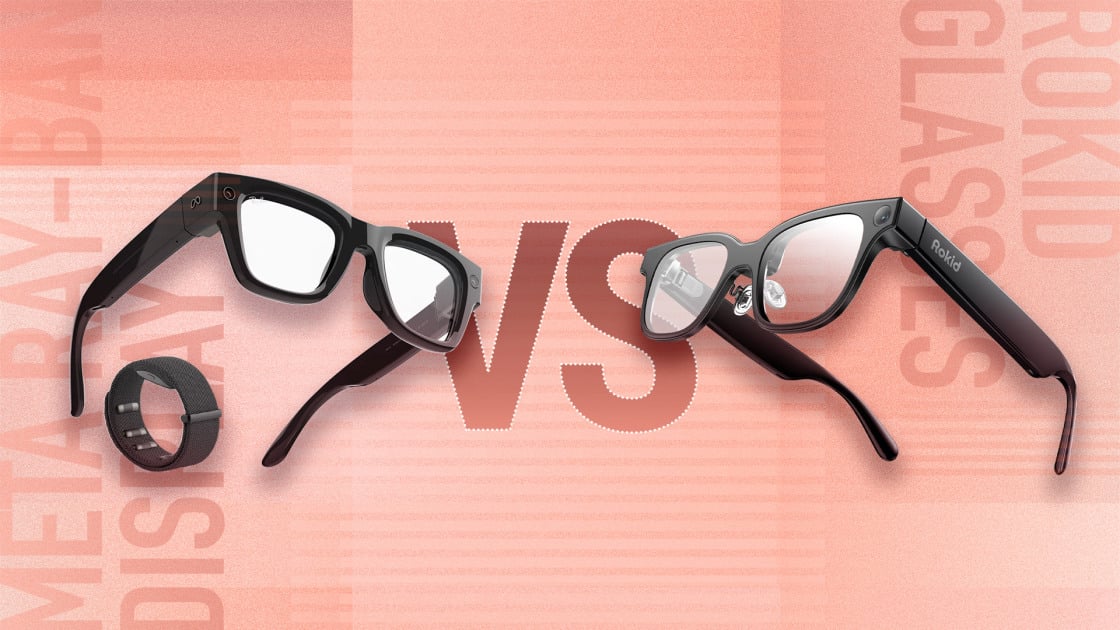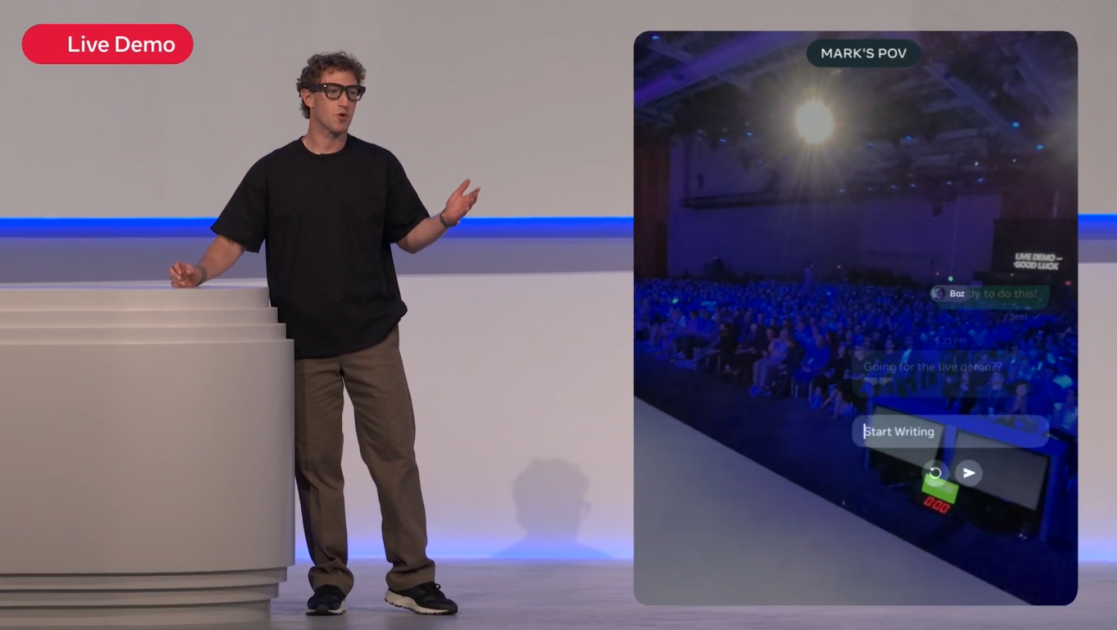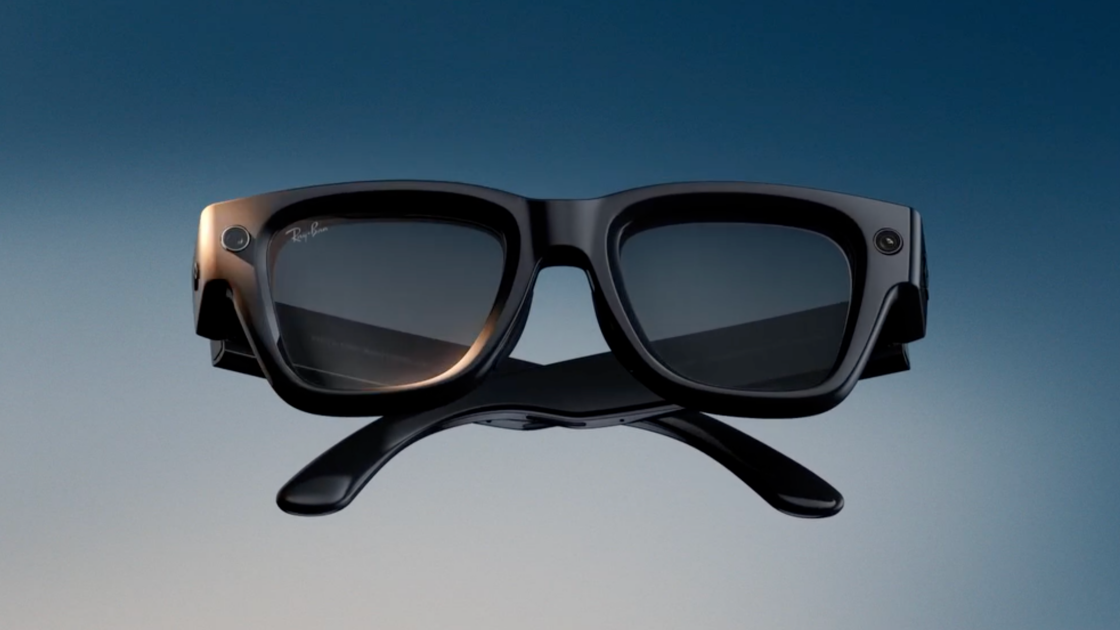Meta Ray-Ban Display…

The Meta Connect keynote delivered several major announcements, but the standout was unquestionably the Meta Ray-Ban Display, Meta’s latest smart glasses and the first to feature an integrated waveguide display. They also introduce a potentially game-changing control method: the Meta Neural Band. These glasses could represent a significant leap in wearable tech, but they’re not alone in the race.
I’ve been covering smart glasses for years, and recently, I’ve been testing the upcoming Rokid Glasses. A full review is on the way, but even now, Rokid’s design already stands out as one of the most polished and user-friendly in its class. Meta’s glasses share some similarities, but in many ways, they take a very different approach. Here’s what you need to know—based on Meta’s announcements and my hands-on time with the Rokid Glasses.
Display
Both glasses use waveguide displays, which rely on etched patterns in flat lenses to channel images from a microprojector to the eye. This allows for slim, lightweight smart glasses, avoiding the bulky prisms used in video-centric models like the XReal One Proo. Because waveguide lenses are fully transparent when off and consist of just a single thin layer between your eye and the world, they’re safer and more comfortable to wear in everyday settings. However, the trade-off is lower image quality—waveguides offer lower resolution and much narrower fields of view compared with prism-based displays. The projected visuals are smaller and less sharp.
The waveguide display in the Rokid Glasses (Credit: Will Greenwald)
The Meta Ray-Ban Display offers a 600-by-600-pixel resolution with a 20-degree field of view, while the Rokid Glasses provide a lower 480-by-398 resolution but a slightly wider 23-degree field of view. Crucially, the Meta glasses display in full color, whereas Rokid’s output is limited to green. This gives Meta a clear edge for richer content, including video—though it’s still far less capable in that regard than prism-based models like the XReal One Pro, which has a 1,920-by-1080 resolution and a wide 57-degree field of view.
That said, the Rokid Glasses have one key advantage: binocular projection. Both lenses feature waveguide displays, whereas the Meta Ray-Bans only project through the right lens. For users with left-eye dominance, this could significantly affect the viewing experience.
Winner: Meta (Full-color and higher resolution, as long as your right eye is your dominant one)
Camera
A photo taken by Rokid Glasses (Credit: Will Greenwald)
Both smart glasses are equally equipped here, with 12MP cameras that can capture 4,023-by-3,024 photos. The Rokid Glasses have an edge in video, though, with the ability to shoot 2,400-by-1,800 clips compared with the Meta Ray-Ban Display’s 1,920-by-1,440 video resolution. I haven’t seen the Meta glasses’ output yet, but test shots I’ve taken with the Rokid Glasses look quite good.
Winner: Rokid (Rokid’s video resolution is higher)
Phone and Video Calls
If you want to make voice calls, both sets of smart glasses have you covered with their speakers and microphones. If you want to make video calls on your glasses, though, you have to go with Meta. The Meta Ray-Ban Display can make two-way video calls that show whoever you’re talking to on the color display and let them see what you’re looking at as well. The Rokid Glasses don’t have any functions like that.
Winner: Meta (Rokid can’t do video calls at all)
Controls
The Meta Neural Band is used to control the glasses (Credit: Meta)
The Rokid Glasses offer a straightforward interface, featuring a touch-sensitive surface on the right temple for tapping and swiping, along with voice control capabilities. Meta, however, may be taking a bold leap forward with its Ray-Ban Display smart glasses. These are paired with the Meta Neural Band—a wristband that, according to Meta, reads your muscle activity to control the glasses. During the Meta Connect event, the band was shown navigating menus and even typing text, suggesting it could serve as a model for future wearable input systems. Then again, it might turn out to be a one-of-a-kind, highly intuitive interface—similar to the eye tracking on the Apple Vision Pro—or just as easily prove to be clunky and inconsistent. Time will tell.
Winner: Meta (The wristband could be revolutionary, if it works)
AI Features
Meta heavily promotes its AI capabilities, even branding its smart glasses as “AI glasses.” Naturally, the Meta Ray-Ban Display comes with Meta AI built in and is fully voice-controlled. It can display visuals like photos and videos alongside its answers, giving it an advantage over the text-only Rokid.
Rokid, on the other hand, offers users a choice between two third-party AI agents—ChatGPT or Qwen. These are standalone large language models (LLMs), not integrated into a broader ecosystem like Meta’s. That could be a plus if you prefer keeping your interactions separate from your social media data.

Get Our Best Stories!
All the Latest Tech, Tested by Our Experts

By clicking Sign Me Up, you confirm you are 16+ and agree to our Terms of Use and Privacy Policy.
Thanks for signing up!
Your subscription has been confirmed. Keep an eye on your inbox!
Both devices support visual processing, allowing you to ask about what you’re looking at and receive a response. But as with any AI, the usefulness, accuracy, or clarity of those responses can vary widely.
Winner: Meta (Color pictures tips answers in Meta’s favor)
Live Translation and Captioning
A dramatization view of the Meta Ray-Ban Display live captioning feature (Credit: Meta)
Whether you’re hard of hearing or just don’t know the language, you’ll be covered by both the Meta Ray-Ban Display and the Rokid Glasses. Both smart glasses have live translation that can recognize what is being said to you and show it as text in your native language on their displays. You can also go English-to-English (or whatever language you prefer) for live captioning, which is a particular boon for users who are hard of hearing. I’m not sure how good the Meta smart glasses work on this front, but I’ve been impressed by the Rokid Glasses so far.
Recommended by Our Editors
Winner: Tie (It’s proven tech made better with a display in front of your eyes)
Battery Life
You won’t get a full day’s use out of either of these smart glasses, as Meta and Rokid both say their respective devices will last up to six hours before you have to charge them.
Winner: Tie (Or no one, since six hours is pretty short)
Price
The $599 Rokid Glasses (Credit: Will Greenwald)
Meta wants $799 for the Ray-Ban Meta Display. The Rokid Glasses will be $599 after their crowdfunding campaign finishes on Oct. 10, but before then, you can preorder them for $479. Yes, it’s on Kickstarter, but Rokid has a proven track record with its non-waveguide smart glasses like the Rokid Max 2, and I already have the actual glasses in hand, so they aren’t ambitious vaporware.
Winner: Rokid (It’s $200 cheaper, but neither set is priced to impulse buy)
The $799 Meta Ray-Ban Display (Credit: Meta)
Which One Is the Future of Smart Glasses?
After spending some time with the Rokid Glasses, they already feel like a more refined and polished step forward compared with earlier waveguide smart glasses I’ve tested, such as the Even Realities G1 and the Vuzix Z100. They’re more intuitive and reliable, and I can easily see myself using them regularly for quick tasks like snapping photos or translating languages without needing to change how I normally use my devices or learn anything new.
The Meta Ray-Ban Display, on the other hand, is aiming much higher. Its boldest move is the Meta Neural Band, a completely different control system that could be either groundbreaking or frustrating—and that one feature will likely define the entire experience. If it had a more traditional interface, like Rokid’s touch surface, the high-resolution, full-color display would be a standout feature (especially for right-eye-dominant users). That said, if you’re not comfortable with Meta AI essentially seeing and hearing everything you do, that alone might be a deal-breaker. From a hardware perspective, the Meta Ray-Ban Display looks like the more advanced option—just one that comes with a wristband-shaped wildcard.







